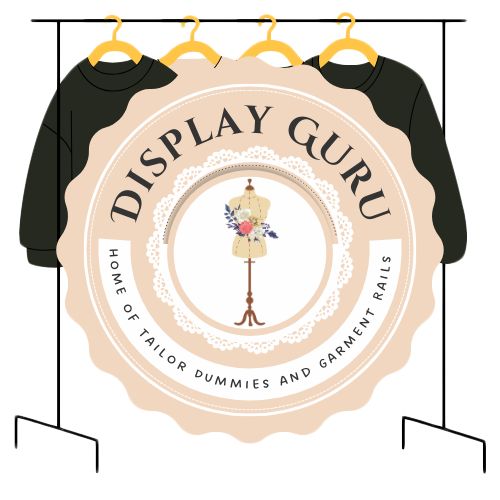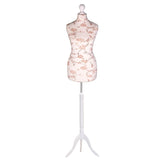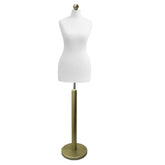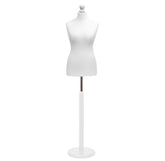Your Guide to the Best Torso Male Mannequin
A torso male mannequin is more than just a display tool; it's a silent ambassador for your brand, designed to spotlight your upper-body garments and pull focus right where you want it. Whether in a bustling high-street window or a crisp e-commerce photoshoot, it’s a proven workhorse for modern menswear.
Why a Torso Mannequin Is Your Secret Weapon
Think of a torso mannequin as a dedicated stage for your clothing. It's a simple but brilliant idea: by removing the legs and lower body, you get rid of all distractions.
This immediately sharpens the viewer's attention on what really matters. A jacket, for instance, doesn't just hang; it drapes naturally over a well-defined shoulder contour, making every detail pop and practically begging customers to take a closer look.
- It draws the eye directly to jackets, shirts, and knitwear with undivided attention.
- You can create powerful, compact window displays that leave a lasting impression, even in tight spaces.
- For e-commerce, it enhances product photos by showing a realistic drape and fit.
- Styling becomes much faster, saving precious time when dressing and redressing displays.
This versatility makes the torso mannequin a genuine strategic asset, equally at home in a boutique window and an online photography studio. Retailers can even match the form's colour and finish to their brand style, ensuring a cohesive look across all visual campaigns.
Key Benefits of a Torso Display
- Focused Attention: A torso form zooms in on your key garments, instantly boosting their perceived value.
- Space Efficiency: Its compact size is a lifesaver in smaller shop interiors and modular layouts.
- Quick Setup: These lightweight forms are a breeze to work with, cutting dressing time by up to 30% during store refreshes.
But don't just take my word for it. The market tells a pretty clear story:
The UK male torso mannequin market is a specialised segment within the broader UK mannequin industry, which generated USD 278.2 million in revenue in 2023 and is forecasted to reach USD 649.7 million by 2030, driven by a CAGR exceeding 10%. Fibreglass leads with a 68.51% revenue share for its durability and realistic finish. Learn more about the UK mannequin market on Grand View Research
This rapid growth really underlines why a torso display deserves a prime spot in your visual strategy.
When a customer sees a garment presented in perfect proportion, free from any clutter, a clear and compelling narrative emerges. This single focal point turns your mannequin into a powerful brand storyteller.
If you're looking to take your window or in-store concepts to the next level, you might be interested in our guide on visual merchandising guidelines.
Maximising Space And Impact
Using compact displays frees up valuable floor space, which means you can showcase more styles without your store feeling cluttered.
Online, the benefits are just as significant. Consistent, high-quality imagery that highlights fabric texture and an accurate fit can do wonders for reducing returns.
By guiding the customer’s eye exactly where you want it, a torso mannequin becomes your most effective silent salesperson. It transforms every angle into a storytelling moment, driving engagement and reinforcing your brand's identity.
With the right layout and lighting, a male torso mannequin can elevate a simple outfit into a truly compelling presentation, delivering maximum impact both in-store and online.
Choosing Your Mannequin's Material
Picking the right material for your male torso mannequin is a bit like choosing the right fabric for a suit. It's not just about looks; it dictates durability, weight, and the overall feel of your display. The material you select has a huge impact on how your clothes are presented and how well the form holds up to the daily hustle of a retail environment.
Think of it this way: are you looking for a long-lasting, premium workhorse or something more lightweight and flexible for displays that change on a whim? Each material has its own character and strengths, and getting to know them is the key to making a smart investment for your brand.
Fibreglass: The Industry Standard
For years, fibreglass has been the go-to choice for high-end retail displays, and it’s easy to see why. It delivers a premium, smooth finish that can be painted in any colour imaginable, from a classic matte white to a striking high-gloss black. This adaptability means it can effortlessly match any brand aesthetic, whether you're a luxury boutique or a trendy high-street shop.
When it comes to durability, fibreglass is the undisputed champion. It’s tough, scratch-resistant, and built to last, which makes it a fantastic long-term investment. Yes, it’s heavier than its plastic cousins, but that substantial feel often translates to a perception of quality and permanence. Its long history and continued presence in top-tier stores speak for themselves.
Interestingly, market analysis shows that UK mannequin manufacturing really took off after 2010, with the male torso form becoming a common sight by the mid-2010s. This boom coincided with advances in materials like fibreglass, which made up over two-thirds of all mannequin construction in 2023. These improvements allowed for much more realistic textures and dynamic poses. You can dive deeper into the market trends with IMARC Group's research.
Lightweight and Versatile Plastics
While fibreglass brings a certain gravitas, modern plastics like PVC and ABS present a seriously compelling alternative, especially when budget and flexibility are key. These materials are much lighter, making the mannequins incredibly easy to move, dress, and reposition. This is a massive plus for businesses that refresh their displays frequently, like pop-up shops or trade show exhibitors.
Plastic mannequins are also more forgiving when it comes to the occasional knock or drop. Instead of chipping or cracking like fibreglass might, they tend to bounce or dent, making them a practical choice for busy, high-traffic areas where accidents are bound to happen.
Expert Tip: If you're working with a tighter budget or need displays for a temporary setup, a high-quality plastic torso mannequin strikes the perfect balance between affordability, low weight, and respectable durability.

The image above really highlights the trade-offs. While fibreglass is the clear winner on longevity, you can see how PVC and ABS offer major advantages in cost and weight, which can be crucial for many businesses.
A Closer Look: Comparing Materials
To make the decision easier, it helps to see the key features of each material side-by-side. Think about what matters most for your daily operations—is it the initial cost, the ability to move it easily, or its ability to withstand wear and tear?
Comparison of Male Torso Mannequin Materials
| Material | Key Characteristics | Best Suited For | Average Lifespan |
|---|---|---|---|
| Fibreglass | Premium smooth finish, heavy, highly durable but can chip if dropped. Highly customisable with paint. | High-end boutiques, department stores, and long-term, static displays where quality is paramount. | 8-15+ years |
| Plastic (PVC/ABS) | Lightweight, affordable, and resistant to breakage (dents rather than cracks). Less premium finish. | Pop-up shops, trade shows, fast-fashion retailers, and high-traffic areas needing frequent changes. | 3-7 years |
| Eco-Friendly | Made from recycled or biodegradable materials. Often have a unique, textured look. Varies in durability. | Brands with a strong sustainability focus, concept stores, and businesses wanting to make a green statement. | 4-10 years (Varies) |
Ultimately, this table shows there's no single "best" material—only the best one for your specific needs and brand values.
The Rise of Eco-Friendly Options
In recent years, sustainability has rightly moved from a niche concern to a core business consideration. In response, mannequin manufacturers are now offering some fantastic eco-friendly alternatives, often made from recycled plastics or innovative biodegradable composites.
Opting for a sustainable male torso mannequin is a powerful way to show customers what your brand stands for. These forward-thinking options let you create stunning displays without compromising on your commitment to the environment.
- Recycled Composites: These often feature a unique, slightly textured finish that can add real character and a modern edge to your visual merchandising.
- Biodegradable Polymers: A great choice for brands that are laser-focused on minimising their long-term environmental footprint.
The right material is out there for you. For more inspiration on how to make your mannequin a central part of your shop's story, have a look at our guide on using a mannequin on a stand. Whether you need timeless durability, practical flexibility, or a sustainable solution, you can find the perfect material to bring your creative vision to life.
Matching Mannequin Size And Shape To Your Apparel

Getting the right male torso mannequin isn't just about having something to hang a shirt on. It's about making each piece look like it was designed specifically for that form. When the mannequin’s size and shape perfectly complement your clothing, you’re not just displaying a garment; you're telling a visual story that feels aspirational and tailored.
Think about it: a classic button-down shirt just hangs better on a form with a defined, natural shoulder slope. On the other hand, high-performance athletic wear needs a mannequin with broader contours to truly show off its fit and function. It's this synergy between form and fashion that turns a simple display into a powerful sales tool.
To get it right, you'll want to focus on a few key things:
- Standard UK menswear chest measurements.
- The different mannequin physiques available.
- How the form aligns with your garments' intended fit.
- The way the mannequin's style reflects your brand identity.
Standard Menswear Sizes And Mannequin Forms
Here in the UK, the average male chest size is around 40 inches, and modern torso mannequins are finally catching up. Manufacturers are now producing forms that align with up-to-date British male body data, which means you can get a far more realistic fit for your clothing right off the shelf.
Mannequin forms generally come in three main builds: slim, standard, and athletic. These are designed to mirror common suit sizes like 38R, 40R, and 42R. By picking the form that matches your brand's sample size, you ensure the clothes hang exactly as the designer intended, avoiding any awkward pulling or sagging.
| Chest Size (inches) | Mannequin Build |
|---|---|
| 38 | Slim Formalwear Frame |
| 40 | Standard Garment Form |
| 42 | Athletic Display Build |
For a more granular look at all the critical measurements, our guide on precise mannequin measurements is a great resource.
Realistic And Abstract Torso Mannequin Shapes
The shape you choose says a lot about your brand. Realistic torsos are crafted with lifelike shoulders and subtle contours, making them perfect for classic menswear. They help customers instantly picture themselves wearing the garment because the silhouette feels familiar and human.
Abstract torsos, in contrast, strip away the anatomical detail. They offer a more sculptural, artistic look that puts the focus squarely on the fabric, cut, and design of the clothing. This minimalist approach works wonders for contemporary, high-fashion, or avant-garde collections aiming for a modern, sophisticated aesthetic.
The choice between a realistic and an abstract form really sets the tone for your entire display and can dramatically shift how a customer perceives your brand.
Here are a few common strategies we see work well:
- Realistic Headless Torsos: Ideal for everyday wear and commercial displays.
- Abstract White Forms: A go-to for high-fashion exhibits and minimalist brands.
- Athletic Contoured Mannequins: The only choice for sports and performance collections.
Matching Build To Style And Material
The mannequin's build should echo the style of the clothing. An athletic build, with its defined chest and broad shoulders, is purpose-built for showcasing sportswear and performance gear. A slender frame, conversely, is all about accentuating the clean, sharp lines of a tailored shirt or jacket.
Don't forget the fabric itself. The material plays a huge role in how a garment drapes and looks on a form. If you want to dive deeper, there are excellent guides on different t-shirt materials that can offer some great insights.
Here are a few tried-and-true pairings to get you started:
- Formalwear: Stick with slim to standard frames that have a natural shoulder slope.
- Casual Tees: Standard forms are perfect for showing off a relaxed, comfortable fit.
- Sports Gear: Go for athletic builds with dynamic, powerful contours.
- Contemporary Designs: Use abstract shapes to make the silhouette the star of the show.
Ultimately, by carefully matching the build and shape to your apparel, you create a display that truly connects with your target customer. It’s about making your clothing look its absolute best.
How to Use Torso Mannequins in Your Business
So, you’ve picked out the perfect torso. Now what? The real magic happens when you put it to work. Think of your mannequin as more than just a display form; it's a silent salesperson, a vital link between your product and your customer, whether they're walking through your door or browsing your website.
A well-styled torso can take a simple shirt or jacket and turn it into something desirable. It gives the garment context, shows off the fit, and tells a visual story that a piece of clothing on a hanger just can't.
Creating High-Impact Retail Displays
In a physical shop, torso mannequins are brilliant for making a big impact without taking up too much floor space. Their focused shape lets you create powerful visual moments that grab a customer's attention instantly.
It's like putting a spotlight on your star products. When you display a new-season jacket or a premium shirt on a torso, you're telling shoppers, "Look at this." It immediately elevates the item.
Here are a few proven ways to use them in-store:
- Dynamic Window Displays: Don't just stick one in the window. Group a few torsos together at different heights to build a layered, interesting scene. This is perfect for showcasing a new collection or a specific theme.
- In-Store Focal Points: Place a styled torso at the end of an aisle or in a busy area. It breaks up the monotony of clothing rails and acts as a signpost, guiding customers towards key pieces.
- Tabletop and Shelf Styling: Because they're so compact, they're ideal for placing on tables alongside folded jumpers and accessories. You can create a complete, styled "look" in a very small space.
Getting your displays right is a mix of art and science. For more inspiration on making your shop pop, check out these top store display ideas.
Transforming E-commerce Product Photography
For anyone selling clothes online, your photos are everything. A male torso mannequin is probably one of the best investments you can make to improve your product images and earn your customers' trust.
Flat-lay photography is common, but it often fails to show how a garment truly fits or hangs. A torso gives that crucial third dimension, helping customers picture how the item will actually look on a real person.
The jump from a flat image to a 3D form is huge. It answers the customer's biggest question: "How will this look on me?" Answering that question well removes doubt and makes it much easier for them to click "buy."
This isn't just about pretty pictures; it has a real impact on your numbers. When customers have a clear, accurate idea of what they're buying, they feel more confident. This not only boosts sales but has been shown to reduce return rates by up to 25% in certain clothing categories. Less returns means happier customers and more profit.
A Multi-Channel Marketing Asset
The value of a good torso mannequin doesn't stop at your shop floor or product page. It's a fantastic tool for creating content across all your marketing channels, especially visual-heavy platforms like Instagram and Pinterest.
Great social media content often shows products in an aspirational, lifestyle-focused way. A styled torso gives you a clean, professional canvas to build these stories.
Social Media Content Ideas:
- "Get the Look" Posts: Style a complete outfit on the torso—shirt, jacket, even a necklace—and turn it into a shoppable post.
- Behind-the-Scenes Styling: Film a quick video of you dressing the mannequin. It’s a great way to share styling tips and show your personality.
- Detail Shots: Use the mannequin to get crisp, close-up shots of fabric textures, button details, or unique stitching that might otherwise be missed.
Of course, dressing a mannequin to look its best is a skill. To make sure every garment is shown off perfectly, take a look at our guide on how to dress a mannequin. It’s packed with professional tips to get it right every time.
A Practical Checklist for Your Purchase
Choosing the right male torso mannequin can feel overwhelming, but it doesn't have to be. Think of it less like a simple purchase and more like casting the perfect silent salesperson for your brand. This practical guide will walk you through the essential steps, helping you cut through the noise and make a confident decision.
We'll break down everything from matching the mannequin to your brand's unique personality to making sure it physically fits your space. Let's get started.

Define Your Brand Aesthetic
First things first: what is your brand’s story? Before you even think about materials or finishes, you need to be crystal clear on your aesthetic. Is your identity sleek, modern, and minimalist? Or is it more about bold, colourful streetwear?
The mannequin you choose is a direct extension of this identity. A crisp, monochrome matte finish beautifully complements high-end tailoring, letting the quality of the fabric speak for itself. On the other hand, a gloss black form might be the perfect backdrop for the vibrant energy of an athleisure line.
Your brand guidelines or mood boards are your best friends here. Use them to narrow down your options. Remember, every choice, from the colour to the subtle silhouette, shapes how a customer perceives your collection.
Key Insight: Visual consistency is king. When your displays align with your brand identity, you build stronger, more memorable connections with your customers.
Assess Your Display Space
Next, it’s time to get practical and break out the tape measure. It sounds obvious, but you’d be surprised how many people overlook this step. Before you fall in love with a particular model, you need to know exactly what space you're working with.
For an online store, this is about getting high-resolution images that pop. For a physical shop, it’s about stability and presence. Sketch out your floor plan, noting the width and depth of your display areas, and pay close attention to the lighting angles.
A compact torso male mannequin can be incredibly versatile, fitting neatly onto shelves or into tight window displays. But always leave enough room for your team to manoeuvre around it for styling and quick changes. Don't forget to account for things like door swings and customer foot traffic—the last thing you want is a beautiful display causing a bottleneck.
Set Your Budget
Let's talk money. It’s always tempting to go for the cheapest option, but a mannequin is a long-term investment in your brand's presentation. Balancing the upfront cost with durability is crucial. A low-priced form might save you money today, but it could cost you more in frequent replacements down the line.
A good way to frame it is by estimating the cost per display cycle. This helps you compare different options based on their long-term value, not just their initial price tag.
Evaluate Finishes And Fittings
The devil is in the details, and with mannequins, those details are the finishes and fittings. The base, for example, plays a huge role in both aesthetics and function. You might opt for a sleek, round metal stand or a more minimalist wooden tripod—each sends a different message.
Critically, you need fixtures that are stable. The mannequin shouldn't wobble, and it should be easy for your team to dress and reposition. If you can, always try to see sample finishes in person. Colours and textures can look very different on a screen, and you want to avoid any surprises.
Here are a few pointers for choosing the right finish:
- Matte surfaces are fantastic for reducing glare, which really helps to highlight the texture and detail of the fabric.
- Gloss finishes catch the light and create a sense of drama, making them perfect for bold, eye-catching styles.
- When in doubt, neutral tones like white, grey, or black are incredibly versatile and work well with almost any collection.
Choose Where To Buy
Where you buy your mannequin is just as important as which one you buy. For quality assurance and proper service, it’s almost always best to purchase from a specialised retail display supplier.
While online retailers offer a huge variety and competitive pricing, make sure you dig a little deeper. Look for clear warranty information, fair return policies, and a customer support team that's responsive and helpful. If you're planning a big order, always verify stock levels and lead times to avoid delays.
For more in-depth advice on this, our guide on how to buy a dress form has some great transferable tips.
Mannequin Selection Checklist
To tie this all together, we've created a simple checklist to guide your final decision. Use this table to systematically think through your options and ensure you've covered all the important bases before you commit.
| Consideration | Key Questions to Ask | Recommended Option For... |
|---|---|---|
| Brand Aesthetic | Does the mannequin’s style, colour, and finish align with my brand identity? | Matching high-end, minimalist, or streetwear vibes. |
| Display Space | Will it physically fit my layout and allow for easy access and styling? | Smaller spaces like shelves, countertops, or window displays. |
| Budget | Does the price reflect good long-term value and durability? | Retailers planning for permanent or long-lasting installations. |
| Finish and Colour | Will the finish complement my garments without causing glare or distraction? | Showcasing seasonal collections or specific fabric textures. |
| Supplier Support | Does the supplier offer a warranty, good service, and a clear return policy? | First-time buyers or businesses making a significant investment. |
By working through these questions, you can move forward with confidence, knowing your choice is a strategic one that will enhance your products and your brand.
Final Tips
Before we wrap up, here are a few final pieces of advice from the field:
- Always confirm delivery times, especially if you're working towards a seasonal launch or a new campaign.
- Once unboxed, take a quick photo of the mannequin in your store. This simple step helps you preview how it looks in your actual lighting and environment.
- Keep a record of your purchase details. This makes reordering easier and is essential for any warranty claims.
- Consider keeping a few spare parts or a small repair kit on hand for any quick fixes that might be needed.
With this checklist in hand, choosing the right torso male mannequin becomes a much more straightforward and strategic process. You can invest confidently, knowing your new display will not just hold clothes, but truly amplify your brand message and captivate your shoppers.
Caring for Your Mannequin to Ensure Longevity

Think of your torso male mannequin as a long-term investment in your brand's image. Just like any professional equipment, it needs a bit of upkeep to stay in top form and continue reflecting the quality you stand for. A simple, consistent care routine is all it takes to stop minor scuffs from becoming permanent eyesores and keep your displays looking sharp.
The first step is knowing what your mannequin is made of. A fibreglass model, for instance, will need a gentler touch than a hard-wearing plastic one. For any material, a regular once-over with a microfibre cloth is your best defence against dust and grime.
Routine Cleaning and Minor Repairs
When it's time for a proper clean, you rarely need more than a bit of mild soap and warm water. Make sure to use a soft, non-abrasive cloth to avoid creating those tiny scratches that can dull a glossy finish over time. Steer clear of harsh chemical cleaners or scourers—they can strip the paint or damage the surface for good.
In a busy shop, scuffs and fingerprints are simply part of the territory. Here’s how to handle them:
- Fingerprints: A quick buff with a clean microfibre cloth is usually enough to lift oily marks.
- Minor Scuffs: On matte finishes, a simple pencil eraser can work like magic on light scuffs.
- Deeper Scratches: For anything more serious, your best bet is a touch-up paint kit, which you can often get directly from your mannequin supplier.
Treating your mannequin with the same care you give your fixtures isn't just about looks. A consistent cleaning schedule is a simple way to dramatically extend its working life.
Proper Handling and Storage
What you do with your mannequin when it's off the floor is just as important as how you clean it. Proper storage is your key to preventing chips, fading, and other damage.
If you still have it, the original packaging is your best friend for long-term storage, offering the perfect protection from dust and accidental bumps. No box? No problem. Wrap the torso securely in bubble wrap or a soft blanket.
Find a cool, dry spot away from direct sunlight, which is notorious for fading colours. And always lay the mannequin down on a soft surface—never stand it up where it could easily be knocked over. These small habits will ensure your torso mannequin remains a valuable display asset for years to come.
Got Questions? We've Got Answers
You're not alone in wondering about the finer points of torso mannequins. Let's tackle some of the most common questions we hear from retailers and photographers.
Why Choose a Torso Over a Full-Body Mannequin?
The main advantage? Focus. A torso mannequin strips away the distractions of legs and lower body, pulling the customer's eye directly to your shirts, jackets, or knitwear. They're also brilliant space-savers and much easier to dress and move around, making them perfect for smaller boutiques or frequent display changes.
- Laser-Focused Display: It naturally guides the eye to upper-body garments.
- Space-Smart: Fits perfectly into tight corners and compact window displays.
- Effortless to Use: We've seen retailers reduce dressing time by up to 30% when refreshing their stores.
Can I Use a Torso for Photographing Trousers?
Simply put, no. A torso form ends at the waist or upper thigh, so it's physically impossible to display trousers on one. To get a true sense of fit and detail for any bottom-wear, you'll need to use dedicated leg forms or a full-body mannequin.
To Head or Not to Head?
This really comes down to your brand's aesthetic. Headless torsos have a clean, minimalist feel that lets the garment's fabric and silhouette do all the talking. On the other hand, a torso with an abstract head can help complete a look, giving shoppers a better sense of proportion, especially when you add accessories like hats or scarves.
- Headless models are ideal for modern, product-focused brands.
- Abstract-headed forms are great for telling a lifestyle story or showing a complete outfit.
Are They Adjustable?
While most shop-floor torsos are static to ensure a consistent drape day in and day out, you do have options. Professional tailoring forms often have dials to adjust the chest, waist, and hip measurements. For visual merchandising, you can find models with posable arms or height-adjustable stands, which add a dynamic touch to your displays.
- Static torsos give you a reliable, uniform look across your store.
- Posable arms offer brilliant versatility for layering or showing off movement.
- Adjustable stands let you adapt the display to different shelf heights or window depths.
A Final Checklist Before You Buy
Before you make a final decision, run through these quick points.
- Does the mannequin's build match the fit of your core clothing line?
- Headless or headed? Make sure it aligns with your brand's visual identity.
- Consider the material. Will the weight and finish work in your display environment?
- Check the dimensions. Will the stand or form fit your existing shelves and spaces?
- Always confirm the details on shipping and customer support before you order.
Getting these details right will ensure you choose a torso male mannequin that not only looks great but actively helps drive customer engagement.
Happy styling!
For professional display tools you can rely on, Display Guru offers a complete range of torso male mannequins and accessories. Explore the collection and order with free shipping.








